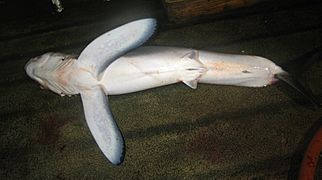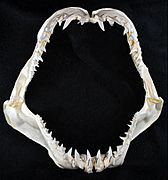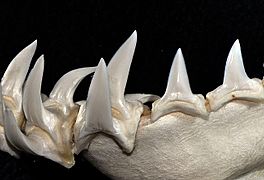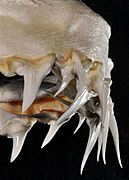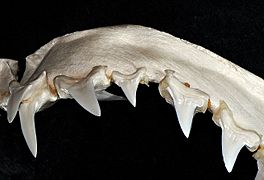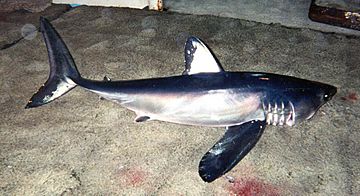Longfin mako shark facts for kids
Quick facts for kids Longfin mako shark |
|
|---|---|
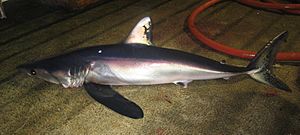 |
|
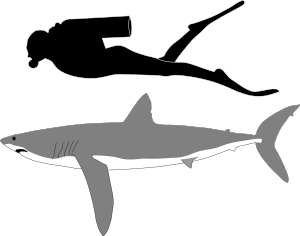 |
|
| Conservation status | |
| Scientific classification | |
| Genus: |
Isurus
|
| Species: |
paucus
|
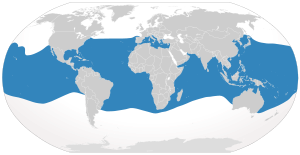 |
|
| Range of the longfin mako shark | |
| Synonyms | |
|
Isurus alatus Garrick, 1967 Lamiostoma belyaevi Glückman, 1964 Isurus oxyrinchus (non Rafinesque, 1810) misapplied |
|
The longfin mako shark (Isurus paucus) is a type of mackerel shark. It belongs to the Lamnidae family, which also includes the famous great white shark. These sharks likely live all over the world in both temperate (mild) and tropical (warm) waters.
This shark is not very common. It is often confused with its more famous cousin, the shortfin mako shark. The longfin mako lives in the open ocean, usually in moderately deep water, sometimes as deep as 220 meters (about 720 feet). It can grow up to 4.3 meters (about 14 feet) long. Its slender body and long, wide pectoral fins suggest it swims slower and is less active than the shortfin mako.
Longfin mako sharks are predators. They eat small schooling bony fishes and cephalopods like squid. Unlike some other sharks in its family, it's not certain if the longfin mako can keep its body warmer than the surrounding water. However, it has special body parts that could allow it to do so.
These sharks give birth to live young, but the babies hatch from eggs inside the mother's body. This is called aplacental viviparous reproduction. As the young sharks grow inside the mother, they eat unfertilized eggs for food. Usually, two pups are born at a time, but sometimes there can be as many as eight.
The longfin mako shark is not very important for commercial fishing. Its meat and fins are not as good as those from other sharks. However, it is often caught by accident by fishing boats. Because it is rare, doesn't have many babies, and keeps getting caught by accident, the International Union for the Conservation of Nature (IUCN) has listed it as an endangered species.
Contents
About the Longfin Mako Shark Name
The longfin mako shark was first described in 1966 by a Cuban marine scientist named Darío Guitart-Manday. He studied three adult sharks found in the Caribbean Sea. The name paucus comes from a Latin word meaning "few." This name was chosen because this shark is much rarer than the shortfin mako.
Scientists use genetic studies to understand how animals are related. These studies show that the longfin mako and shortfin mako are closely related. Their closest relative is actually the great white shark. Scientists have found fossil teeth of the longfin mako in Australia and Japan. These fossils are about 11 to 15 million years old.
Where Longfin Mako Sharks Live
The longfin mako shark lives in tropical and warm-temperate parts of the ocean all over the world. It's sometimes hard to know exactly where they live because they are often confused with shortfin mako sharks.
In the Atlantic Ocean, they have been seen near the East Coast of the United States, in the Caribbean, and off southern Brazil. They are also found from the Iberian Peninsula to Ghana in Africa. They might even live in the Mediterranean Sea. In the Indian Ocean, they have been reported near Mozambique. In the Pacific Ocean, they are found off Japan, Taiwan, northeastern Australia, and southern California.
These sharks live in the open ocean. During the day, they usually stay in the upper mesopelagic zone, which is a dimly lit part of the ocean. At night, they swim up to the pelagic zone, which is closer to the surface. Off Cuba, they are most often caught at depths between 110 and 220 meters (360-720 feet). They are rarely found shallower than 90 meters (300 feet).
What Longfin Mako Sharks Look Like
The longfin mako is the bigger of the two mako sharks. It is the second-largest shark in its family, after the great white shark. It can grow over 2.5 meters (8.2 feet) long and weigh more than 70 kilograms (150 pounds). Female sharks grow larger than males. The biggest longfin mako ever reported was a 4.3-meter (14-foot) female caught off Pompano Beach, Florida, in 1984. Very large ones can weigh up to 500 kilograms (1,100 pounds).
This shark has a sleek, torpedo-shaped body with a long, pointed snout. It has large eyes but no special protective eyelids. Its mouth has many rows of large, knife-shaped teeth that are not serrated. The outer teeth in the lower jaw stick out a lot. Its gill slits are long and extend onto the top of its head.
The most unique feature of the longfin mako is its very long and wide pectoral fins. These fins are as long as or even longer than its head. Its first dorsal fin is large and rounded, located behind the pectoral fins. The second dorsal fin and anal fins are very small. The tail base has strong ridges, and the caudal fin (tail fin) is shaped like a crescent moon.
The shark's skin is covered in tiny, tooth-like scales called dermal denticles. They are oval-shaped with ridges. The top of the shark is dark blue to grayish-black, and its underside is white. The fins are mostly dark, but the anal fin has a white edge. Older sharks often have dark spots under their snout and around their jaws.
Longfin Mako Shark Biology and Life Cycle
Not much is known about the longfin mako's daily life. It is somewhat common in the western Atlantic and central Pacific oceans. However, in the eastern Atlantic, it is very rare.
The longfin mako's body shape, with its slender body and long fins, is similar to slow-swimming sharks like the oceanic whitetip shark and the blue shark. This suggests that the longfin mako is not as fast or active as the shortfin mako, which is known for its speed. Like other sharks in its family, it has special blood vessel systems called rete mirabilia. These systems help other mackerel sharks keep their body temperature warmer than the water around them. It's not certain if the longfin mako can do this, but it has the right body parts.
Longfin mako sharks have large eyes and are attracted to chemical lights, which suggests they hunt by sight. They mainly eat small, schooling fish and squid. In 1972, a female longfin mako was found with a broken swordfish bill stuck in her belly. It's not known if she was hunting the swordfish or if it was an accident. Adult longfin makos usually don't have natural predators, except for killer whales. Younger sharks might be eaten by larger sharks.
Reproduction
Like other mackerel sharks, the longfin mako is aplacental viviparous. This means the eggs hatch inside the mother's body, and the young grow there until they are born live. Usually, two pups are born at a time, one in each of the mother's uteruses. However, in 1983, a female shark was caught with eight well-developed babies inside her.
As the baby sharks develop, they eat unfertilized eggs produced by their mother. This is called oophagy. There is no sign that the babies eat each other, which happens in some other shark species like the sand tiger shark. When they are born, the pups are quite large, measuring between 97 and 120 centimeters (about 3.2 to 3.9 feet) long. They have longer heads and pectoral fins compared to adult sharks.
Records from Florida suggest that female sharks swim into shallow coastal waters during the winter to give birth. Male sharks become ready to reproduce when they are about 2 meters (6.6 feet) long. Females reach sexual maturity when they are around 2.5 meters (8.2 feet) long.
Longfin Mako Sharks and Humans
There have been no reported attacks on humans by longfin mako sharks. However, because of their large size and sharp teeth, they could be dangerous.
These sharks are usually caught by accident by fishing boats. They get caught in longlines meant for tuna, swordfish, and other sharks. They are also caught in gillnets and by hook-and-line. The meat of the longfin mako is sold fresh, frozen, or dried and salted. However, it is not considered very good quality because it can be mushy.
Their fins are also used for shark fin soup, but they are not as valuable as fins from other sharks. Still, the fins are valuable enough that captured sharks are often finned at sea, meaning their fins are cut off and the rest of the shark is thrown back into the ocean. The remaining parts of the shark can be used for animal feed, fish meal, skin, cartilage, and jaws.
Japanese fishing boats that use longlines in tropical waters catch the most longfin mako sharks. These sharks sometimes end up in Tokyo fish markets. From 1987 to 1994, U.S. fisheries reported catching 2–12 tons of these sharks each year, but they were usually thrown away because they weren't worth much in North America. Since 1999, it has been against the law for U.S. fishermen to keep this species in the Atlantic.
The IUCN first listed this species as "Vulnerable" because it is uncommon, doesn't have many babies, and is easily caught by fishing gear. It is also protected under an international agreement called the Migratory Shark Memorandum of Understanding. In the North Atlantic, the number of shortfin mako sharks has dropped by 40% or more since the late 1980s. Scientists are worried that longfin mako populations are also decreasing. In 2019, the IUCN changed the longfin mako's status to "Endangered" because its numbers continue to decline.
See also
 In Spanish: Marrajo carite para niños
In Spanish: Marrajo carite para niños
- List of common commercial fish of Sri Lanka



